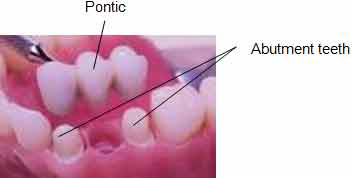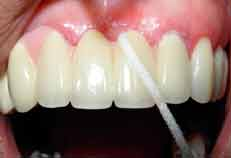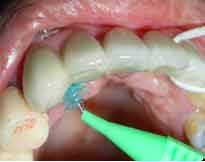Introduction
A crown (cap) is a type of dental restoration which completely caps or encircles a tooth or dental implant, restoring it to its original shape and size, or to the desired shape, size and shade/colour. Crowns are often needed for tooth with large/huge cavity, or heavily restored tooth and to restore a fractured or darkened/undesirable tooth colour or other deformities. They are typically bonded to the tooth using a dental cement.

Picture 1 : Crown
A bridge, also known as a fixed-partial denture. It is used to replace a missing tooth/ teeth by connecting one/two adjacent teeth or dental implants. In other words, one/two natural teeth on each sides are converted into crowns which are then linked together to form a bridge to replace the missing tooth/teeth in the middle, offering about the same advantages and limitations of a crown.

Picture 2 : Bridge
Life span
Life span of crowns & bridges varies between 7 to 10 years. However it is subjected to many factors, for example the oral hygiene – the most and foremost factor; the occlusion (biting), the chewing pattern and the span of bridges either short or long span.
Common Failure of Crowns & Bridges (Unserviceability)
Failure of crowns & bridges commonly due to
- Caries / decay – due to poor oral hygiene
- Crowns decementation
- Defective margins
- Excessive wear of gold or porcelain
- Periodontal disease
- Mobility of abutment – natural tooth that supports the crown/bridge
- Periapical involvement
- Broken joint of the bridge
- Broken pontics
- Lost veneer
- Poor aesthetic
Maintenance of Your Crowns/Bridges
It is important to take proper care of your crowns/bridges to ensure optimal function and aesthetic. Proper care will also helps in maintaining healthy surrounding gum and teeth thus ensure prolonged life span of your crowns / bridges. Here’s some tip on how to take care of your crowns / bridges :-
- Self care
- Good oral hygiene
- Effective brushing and flossing at least once a day before bedtime if not after eating.
- Rinse at least after each meal if brushing is not possible (e.g : while eating out)
- Brush around the crown with a soft bristle toothbrush especially where the tooth and crown meets (margin); since harmful bacteria can be harboured at this area to cause decay and gum disease.
- Dental floss
Dental flossing and interdental toothbrush are highly recommended for those who have fixed prosthesis in their mouth. It will help to clean the area that can’t be reached by tooth brushing alone, for example the interdental area and beneath the bridge pontic (Picture 3, 4 & 5).

Picture 3 : Flossing beneath the pontic of the bridge - Interdental toothbrush.
Used to clean around and beneath the bridge pontic.

Picture 4 : Interdental tooth brush
Picture 5 : Interdental tooth brush - Avoid biting hard food, for example bone; using the crown/bridge.
- Good oral hygiene
- Professional care
- Six month periodically check-up or dental visit if any problem related to crowns/bridges exists.
After cementing the fixed prosthesis, the specialist/dentist will normally give six (6) month review appointment or the patient can request for it. It is advisable to have this follow-up visit so that any problem related to the prosthesis can be detected earlier and further correction can be done. - Splint fabrication to protect the crowns/bridges.
Some dentist will provide occlusal splint to their patient after completing the treatment especially if it involves long span and complex cases (many prosthesis). It is meant for protection of the prosthesis upon loading from chewing or abnormal habit (parafunction) eg: night grinding.
- Six month periodically check-up or dental visit if any problem related to crowns/bridges exists.
| Last Reviewed | : | 23 August 2019 |
| Writer | : | Dr. Nor Ziana bt. Ibrahim |
| Accreditor | : | Dr. Ithnaniah bt. Abd Wahab |
| Reviewer | : | Dr. Roshima bt. Mohd Sharif |







